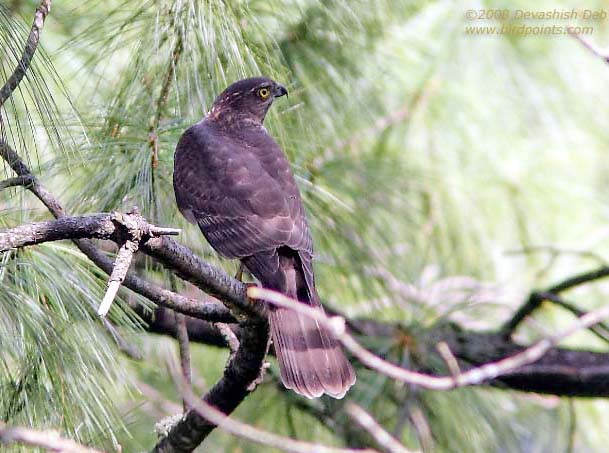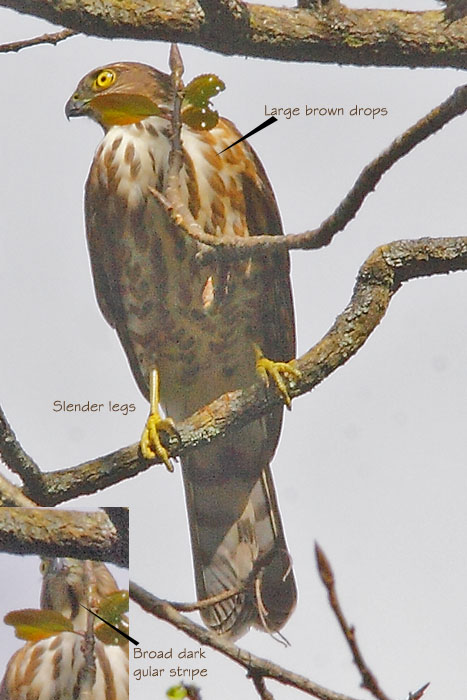|
|
|
Besra
|
Accipiter
virgatus
|
|
29 November
2008
|
|
Possible
regional races (polytypic)
|
|
|
-A. v. affinis; Mees, 1981
|
|
|
-A. v. besra; Jerdon, 1839
|
|
|
-A. v. affinis; Hodgson, 1836
|
|
Pls use the mousewheel
to zoom in/out (Max 2X) |

|
|
Kunjkhrak, near Pangot,
Uttarakhand India, 1 October 2008
A group of Eurasian Jays were noisily trying to drive this juvenile Besra out of their tree and the Besra was aggressively attacking back much more speedily compared to a Shikra. |
 Besra identification:
Besra identification:• Size comparable to Shikra. • Broad tail bars, dark and light bars have equal width. • Slender legs. • Short primary projection, primary tip reaching the third bar. • Broad dark gular stripe (all ages). The stripe is missing in Eurasian Sparrowhawk and faint/grey in Shikra. Juvenile only features: • Longish supercilium. • Brownish back. • Light brown drops on breast and belly etc. (Pls. refer the very useful historical text below). A complete study of the features of Shikra however is first recommended and then the examination of the remaining Accipiters may be started, keeping Shikra as the reference. Historical 1248. Accipiter virgatus. The Besra Sparrow-Hawk. Falco virgatus, Reinw., Temm. Pl. Col. pi. 109 (1824). Accipiter besra, Jerdon, Madr. Jour. L. S. x, p. 84 (1839); id. Ill, Ind. Orn. pls. 4, 29. Accipiter affinis, Hodgson in Gray's Zool. Misc. p. 81 (1844), descr. nulla. Accipiter nisoides, Blyth, J.A.S.B. xvi, p. 727 (1847); id. Cat. p. 22; id. Ibis, 1865, p. 28; 1866, p. 239; 1870, p. 158; Stoliczka, J.A.S.B. xxxvii, pt. 2, p. 13. Accipiter virgatus, Blyth, Cat. p. 22; Horsf. & M. Cat. i, p. 37; Jerdon, B.I. i, p. 52; Stoliczka, J.A.S.B. xli, pt. 2, p. 230; Hume, Rough Notes, p. 132; Jerdon, Ibis, 1871, p. 243; Holdsworth, P. Z. S. 1872, p. 411; Adam, S.F. i, p. 368; Hume, S.F. ii, p. 141; iii, p. 445; iv, p. 280; ix, p. 231; xi, p. 8; id. Cat. no. 25; Sharpe, Cat. B. M. i, p. 150; Blyth & Wald. Birds Burm. p. 62; Gurney, Ibis, 1875, p. 480; A. Anderson, P.Z.S. 1875, p. 19; Butler, S.F. v, p. 226; Hume & Dav S.F. vi, p. 10; Ball, S.F. vii, p. 197; Sharpe, S.F. viii, p. 440; Gurney, ibid. p. 443; Legge, Birds Ceyl. p. 26; Parker, S.F. ix, p. 475; Reid, S.F. x, p. 6; Davison, ibid. p. 335; Oates, B. B. ii, p. 182; id. in Hume's N.&E. 2nd ed. iii, p. 124; Barnes, Birds Bom. p. 24. Astur gularis, Temm. $ Schl. Faun. Jap., Aves, p. 5, pi. 2 (1845-50). Teraspizias rhodogastra, Blyth, Birds Burm. p. 62; nee Nisus rhodogaster, Schleg.; Gurney, Ibis, 1876, p. 278. Coloration. Adult male. Above slaty grey, generally dark, occasionally blackish; nuchal feathers and scapulars white at the base; sides of head paler than crown and rufescent; quills brownish grey above, whitish below, with broad dark cross-bars almost throughout, 7 or 8, including the terminal band, on 4th quill; tail dark ashy above, paler below, with 4 broad black cross-bands on all feathers except the outer pair, which have five or six narrower oblique bars, that disappear in old birds; throat white, generally with a broad dark median band, but this is wanting in some aged specimens; upper breast rufescent, the feathers in the middle with dark shafts and white edges; lower breast, abdomen, and thigh coverts banded white and rufescent brown, but generally suffused with rusty red, especially on the breast and flanks, to such an extent as partially or wholly to conceal the bars; in very old birds the breast becomes pale rufescent or even lavender-grey and the barring scarcely perceptible; vent and lower tail-coverts always white. Adult females differ in being dark brown above; the crown and nape above blackish or dark slaty; wings and tail browner than in males; the throat is white, with a broad dark median stripe: upper breast mostly rufous-brown, only the sides of the feathers in the middle of the breast white, and the brown medial parts of the same often mixed with blackish; lower breast, abdomen, and thigh coverts banded rufous-brown and white, the brown bands growing very broad and the white narrow in old birds; a ferruginous suffusion is occasionally found as in males, but appears to be rare. Young birds brown above, the feathers with rufous margins; beneath buff or brownish white, a dark brown median band on the throat, and large brown spots on the breast, abdomen, and thigh coverts, most elongate on the breast. The spots on the lower parts are replaced by bars as the bird grows older. The Besra is a variable species and undergoes several changes in coloration before it becomes adult, hence many doubts have arisen as to whether one or more species are included. Bill leaden grey, blackish at the tip; cere pale lemon-yellow; irides bright yellow, orange in old birds; legs and feet yellow. A Himalayan female measures: length 14.5; tail 7; wing 8; tarsus 2.15; mid toe 1.5; bill from gape 0.7: the male is smaller, tail 5, wing 6.75. In Ceylon, Tenasserim, and Andaman females the wing is 7 to 7.6 long, in males 5.5 to 6.4. As usual, Northern birds are larger than Southern, Japan and Chinese specimens being even larger than Himalayan, according to Gurney's measurements. The larger Northern race is A. gularis. Probably the Chinese, Malay, and Philippine A. stevensoni is only a variety. Distribution. A resident throughout the Himalayas, and in the great forests of the Peninsula and Ceylon, wandering occasionally into other parts of the country, as young birds have been recorded even from Sambhar and Cutch. It has also been found occasionally in Assam and in various parts of Burma, Japan, China, Southeastern Asia generally, and the Indo-Malayan islands. Habits, &c. A forest-hawk living on small birds chiefly, but also on lizards and insects. It is highly esteemed for sporting purposes by native falconers on account of its speed, courage, and endurance, and is thought by them superior to A. nisus. Very little is known of the breeding, but the nest has been taken by Mr. Gammie in Sikhim and by Mr. H. Parker in Ceylon. Both nest and eggs resemble those of A. nisus. |
About/Terms of use etc. at the home page
Copyright © 2006-2008 birdpoints. All rights reserved.